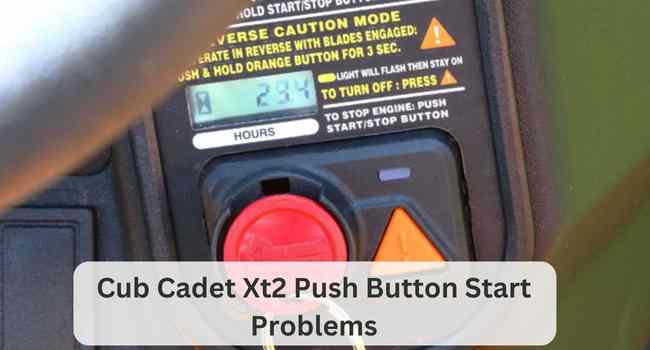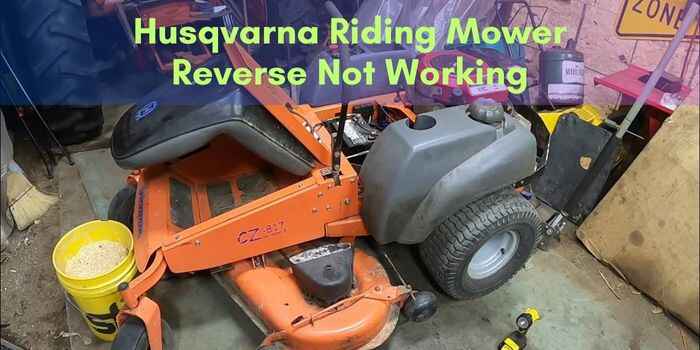Craftsman Riding Mower Won’t Start with New Battery: Troubleshooting Guide
Craftsman riding mower won’t start with a new battery, possible causes may include a faulty ignition switch or a starter solenoid issue. This article will explore common reasons for a riding mower’s failure to start, providing troubleshooting tips to help resolve the problem and get your mower running smoothly again.
Craftsman Mower: New Battery, Still Won’t Start: Quick Troubleshooting
This guide will walk you through diagnosing and solving why your Craftsman mower won’t start.
Step 1: Safety First
- Disconnect the spark plug! Before you touch anything else under the hood, disconnect the spark plug wire. This ensures there’s zero chance of the engine accidentally starting while you’re working.
- While not always strictly necessary, it’s good practice to wear some eye protection and work gloves when troubleshooting mower problems.
Step 2: Ruling Out the Simple Issues
- Faulty Battery: Yes, even new batteries can sometimes be bad. If you have a multimeter, test the voltage – it should be at least 12.4 volts. Auto parts stores can also often test batteries for free.
- Loose Connections: Check that the battery terminals are clean, tight, and free of corrosion. A loose connection could prevent power from reaching the starter
- Safety Switches: Modern mowers have several safety features. Make sure the parking brake is set, you’re in the seat, and the PTO (power take-off for the blades) is disengaged. Check your manual if you’re unsure.
- Bad Fuel: Old, stale gasoline can cause starting trouble. If the fuel has been sitting for more than a month or two, it might be best to drain it and replace it with fresh gas.
Step 3: Diagnosing Deeper
- Starter Solenoid: This little electrical switch sends power to the starter motor. A faulty solenoid often makes a “clicking” sound but doesn’t turn the engine over. You can usually find it by following the thick red cable from the battery’s positive terminal. Online videos demonstrate how to test a solenoid.
- Ignition Switch: Your mower’s key switch may be the culprit. Just like in a car, a faulty ignition switch cuts off the power needed to start. Testing usually involves checking for voltage with a multimeter.
- Fuses: Most mowers have a fuse to protect the electrical system. A blown fuse will prevent starting. Refer to your owner’s manual to locate the fuse and check its condition.
- Seized Engine: This is a worst-case scenario, but it happens. If the engine is extremely hard to turn by hand (even with the spark plug out), it could be seized. This requires professional repair.
Step 4: Additional Considerations
- Wiring Damage: Inspect the wiring for fraying, broken wires, or signs of chewing by rodents. Damaged wiring needs repair.
- Fuel System (Optional): Clogged fuel lines, dirty fuel filters, and gummed-up carburetors can also prevent starting. These problems might deserve their own dedicated blog post.
Step 5: If All Else Fails
- Consulting the Manual: Owner’s manuals have wiring diagrams and specific information on safety switch locations.
- Seeking Professional Help: If you’ve tried these steps and still can’t get the mower running, it may be time to call in a mechanic.
Get ready to troubleshoot your Craftsman riding mower and get back to mowing your lawn in no time.
Craftsman Riding Mower Won’t Start With New Battery: Troubleshooting Guide
Having trouble starting your Craftsman riding mower with a new battery? Don’t worry, our troubleshooting guide is here to help. We provide step-by-step instructions to diagnose and fix the issue, ensuring your mower starts up smoothly.
Checking The Battery Connections:
- Ensure that the battery terminals are securely connected to the correct posts: Check that the positive (+) terminal is connected to the red cable, and the negative (-) terminal is connected to the black cable.
- Inspect the battery cables for any signs of corrosion or damage: Make sure the connections are clean and free from any rust or debris.
- Tighten the battery connections: Use a wrench to ensure that the terminals are snugly tightened, preventing any connection issues.
Inspecting The Ignition Switch:
- Verify that the ignition switch is in the “On” position: Ensure that the key is turned to the correct position before attempting to start the mower.
- Check the wiring connections to the ignition switch: Inspect for any loose or damaged wires that may be preventing the switch from sending the signal to start the mower.
- Test the ignition switch using a multimeter: If you’re comfortable with using a multimeter, you can check the continuity of the switch to determine if it’s functioning properly.
Examining The Solenoid:
- Locate the solenoid on your Craftsman riding mower: It is typically located near the battery or the starter motor.
- Inspect the wiring connections to the solenoid: Check for any loose or corroded connections that may be hindering the flow of electricity.
- Test the solenoid using a multimeter: Similar to the ignition switch, you can use a multimeter to test the continuity of the solenoid and determine if it needs to be replaced.
- Ensure that the solenoid’s terminals are clean and free from any debris: Clean the terminals with a wire brush or sandpaper if necessary.
Battery Connections
Having trouble starting your Craftsman riding mower with a new battery? Check your battery connections to ensure they are secure and properly attached.
Faulty connections can prevent your mower from starting, so it’s important to double-check and make any necessary adjustments.
Having a Craftsman riding mower that won’t start even with a new battery can be frustrating. Before jumping to conclusions and assuming there’s a major problem, it’s important to check the battery connections. Here’s what you can do to ensure proper battery installation, clean the battery terminals, and test the battery voltage:
Ensuring Proper Battery Installation
To start troubleshooting the issue, make sure the battery is correctly installed in your Craftsman riding mower. Follow these steps:
- Check the owner’s manual: Refer to the manual to find the specific instructions for your model’s battery installation.
- Position the battery correctly: Ensure that the battery is securely placed in its designated location within the mower. Make sure it’s not loose or improperly fitted.
- Connect the cables properly: Double-check that the positive cable is connected to the positive terminal (+) of the battery and the negative cable is connected to the negative terminal (-).
Cleaning The Battery Terminals
Over time, dirt, corrosion, and grime can accumulate on the battery terminals, hindering the flow of electricity. Here’s how you can clean the battery terminals:
- Disconnect the battery: First, disconnect the battery cables. Remove the negative cable (-) first, followed by the positive cable (+).
- Inspect for corrosion: Check the battery terminals for any signs of corrosion or buildup. Corrosion often appears as a powdery or fuzzy substance.
- Clean the terminals: Use a wire brush or battery terminal cleaner to gently scrub away any corrosion. Ensure that the terminals are completely free from dirt and grime.
- Rinse with water: After cleaning, rinse the terminals with water to remove any remaining residue.
- Dry and reattach the cables: Use a clean cloth to dry the terminals thoroughly. Once dried, reconnect the positive cable (+) and then the negative cable (-) to the battery terminals.
Testing The Battery Voltage
After ensuring proper battery installation and cleaning the terminals, you’ll want to test the battery voltage to verify its condition. Here’s what you need to do:
- Use a multimeter: Obtain a multimeter or voltmeter to measure the battery voltage accurately.
- Set the meter to DC voltage: Set the multimeter to the DC voltage mode.
- Connect the probes: Attach the positive probe to the positive battery terminal (+) and the negative probe to the negative terminal (-).
- Read the voltage: The multimeter will display the current battery voltage. Ideally, a fully charged battery should have a voltage reading of around 12.6 volts or higher. If the reading is significantly lower, it may indicate a weak or discharged battery that needs charging or replacement.
Ignition Switch
Craftsman riding mower won’t start with a new battery? The ignition switch could be the culprit. If you’re experiencing this issue, consider checking and potentially replacing the ignition switch to get your mower running smoothly again.
Verifying The Connection
When dealing with a Craftsman Riding Mower that won’t start even with a new battery, one of the first components to inspect is the ignition switch.
To verify the connection of the ignition switch, you can follow these steps:
- Ensure the ignition switch is in the “Off” position.
- Locate the wiring harness connected to the back of the ignition switch.
- Gently wiggle the wiring harness to check for any loose or disconnected wires.
- Inspect the wires for any signs of damage or corrosion.
- Reconnect any loose wires and clean any corrosion if necessary.
Testing The Ignition Switch Functionality
To determine if the ignition switch is functioning properly, you can perform a simple test. Here’s what you need to do:
- Make sure the ignition switch is in the “Off” position.
- Set your multimeter to the continuity or resistance mode.
- Touch one lead of the multimeter to the terminal on the back of the ignition switch.
- Touch the other lead to the metal body of the ignition switch.
- If there is continuity or a low resistance reading (close to zero), it indicates the ignition switch is working correctly.
- If there is no continuity or a high resistance reading (infinity or OL on the multimeter), it suggests a faulty ignition switch.
Replacing The Ignition Switch If Necessary
If the ignition switch fails either the connection or functionality test, it’s likely the culprit behind your Craftsman Riding Mower’s starting issue.
Replacing the ignition switch is a straightforward process that you can tackle with these steps:
- Disconnect the battery for safety.
- Locate the mounting screws or bolts that secure the ignition switch to the mower’s control panel.
- Using a screwdriver or appropriate tool, remove the mounting screws or bolts.
- Carefully disconnect the wiring harness from the back of the ignition switch.
- Install the new ignition switch by connecting the wiring harness and securing it with the mounting screws or bolts.
- Reconnect the battery.
With a new ignition switch in place, you should now have a better chance at starting your mower smoothly.
Frequently Asked Questions
Why Won't My Craftsman Riding Mower Start Even With A New Battery?
Sometimes, a new battery may not solve starting problems in Craftsman riding mowers. Other factors, such as a faulty spark plug, clogged fuel filter, or solenoid issues, can prevent the mower from starting.
It’s important to check these components and consult a professional if necessary to diagnose and fix the issue.
How Do I Troubleshoot A Craftsman Riding Mower That Won't Start?
If your Craftsman riding mower won’t start, start troubleshooting by checking the battery for a full charge and ensuring the safety switches are engaged.
Then, examine the spark plug, fuel lines, and air filter for any problems. If these steps don’t resolve the issue, consult the owner’s manual or seek professional assistance.
What Are Some Common Reasons Why A Craftsman Riding Mower Won't Start?
There are several common reasons why a Craftsman riding mower won’t start, including a dead battery, clogged fuel filters, a faulty ignition switch, or a defective starter motor. Another possible cause is a safety switch being engaged or a loose connection.
It’s important to check these components to determine the root cause and take appropriate action.
Final Words
Troubleshooting a Craftsman riding mower that won’t start with a new battery requires a systematic approach and attention to detail. By following the steps outlined in this blog post, you can pinpoint the root cause of the issue and take the necessary actions to get your mower up and running again.
Remember to start with the basics, such as checking the battery connections and ensuring there is fuel in the tank. If those are not the problem, move on to inspecting the ignition switch, starter solenoid, and spark plugs. Don’t forget to consult the owner’s manual if you encounter any difficulties or need further guidance.
Taking the time to properly diagnose and fix the issue can save you from unnecessary frustration and expenses. With the right knowledge and troubleshooting techniques, you’ll be back to enjoying your perfectly functioning Craftsman riding mower in no time.




